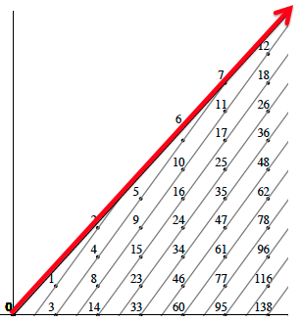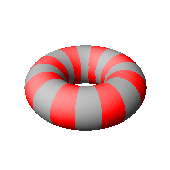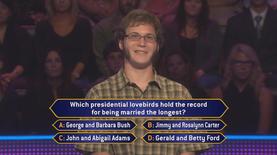
IRIS login | Reed College home Volume 96, No. 2: June 2017
Tags
"Math"
Econ Major Wins Meier Award for Work on Preference

Sarah Brauner ’16 Won a Meier Award for Distinction in Economics for her thesis on preference theory.
“My thesis was a bit unorthodox for a math-econ thesis in that it was more 'mathy' than 'econ-y'—usually it's the opposite,” shares Sarah Brauner ’16, one of two winners of The Gerald M. Meier Award for Distinction in Economics. After receiving this distinction for her exceptional senior thesis, Sarah is now headed to Smith College's Center for Women in Mathematics for a yearlong post-baccalaureate program.
In her thesis, Sarah used sophisticated mathematical modeling to analyze preference theory, the decision-making rationale that is the backbone of microeconomics. Preference theory evaluates how individuals “make decisions based upon an underlying set of preferences for certain goods,” explains Sarah.
“Suppose that you are trying to learn how I would rank apples, bananas and oranges. You know that I prefer apples and oranges to bananas, but you don't know if I favor oranges over apples or vice-versa,” Sarah demonstrates. Imagine you want to find out her 1st, 2nd, and 3rd favorite of the three; then imagine trying to decipher her ranked preferences with even more types of fruit. Only allowing two fruits to be compared at once, Sarah considered the question-asking process as a sorting algorithm using a “partially ordered set, or poset.” Ultimately, Sarah examined the question-asking processes required to learn an individual’s complete preferences.
Continue reading Econ Major Wins Meier Award for Work on Preference
Math Prof Wins Fellowship to Study ?-Loop Spaces
Professor Angélica Osorno [math] has won a Career Enhancement Fellowship from the Woodrow Wilson National Fellowship Foundation. The fellowship aims to give junior faculty the resources needed to aid their scholarly research and academic growth by offering support for twelve months of research and writing.
Prof. Osorno’s area of research is algebraic topology—the study of space and the properties of spaces that are preserved under continuous deformations. In particular, she will study how to construct infinite loop spaces (spaces of great importance in algebraic topology) from specific categorical inputs.
Prof. Osorno earned her PhD in math from MIT and taught at MIT and the University of Chicago before coming to Reed in 2013.
Continue reading Math Prof Wins Fellowship to Study ?-Loop Spaces
Math Prof Wins Grant to Study Infinite Loop Spaces
Prof. Angelica Osorno [math 2013-] has won a Collaboration Grant for Mathematicians in the amount of $35,000 from the Simons Foundation to study infinite loop spaces.
An infinite loop space is a topological space that has a multiplication that is associative, commutative, and unital up to all higher homotopies. Infinite loop spaces are closely related to generalized cohomology theories, and are thus of great importance in algebraic topology.
Prof. Osorno is the principal coordinator on the project, “Categorical inputs for infinite loop machine spaces,” which centers on two aspects of infinite loop space theory: infinite loop space machines for 2-categories and equivariant infinite loop space machines.
Continue reading Math Prof Wins Grant to Study Infinite Loop Spaces
How to Conquer the Number Plane

An ascending 1-stair packing polynomial, which assigns an integer to each co-ordinate in the sector of the plane that has been cordoned off by the hobgoblin's velvet cord (in this example, the hobgoblin chose the sector bounded by a line with slope 8/5).
Imagine dashing into a vast, Borgesian concert hall just before the curtain rises. There’s an infinite number of guests and an infinite number of seats, neatly arranged in rows and columns. Unfortunately, a mischievous hobgoblin has roped off a section of the auditorium with a velvet cord, putting some seats out of commission. How do you, Guest N, figure out where to sit?
Okay, it’s a far-fetched scenario, but math major Maddie Brandt ’15 is the first person in history to solve it in her paper “Quadratic Packing Polynomials On Sectors Of R2,” which she will present at a national conference in January.
The problem of assigning guests to seats is directly related to the problem of mapping the non-negative integers (those friendly, deceptively familiar objects such as 0,1,2,3, and their ilk) onto the co-ordinate plane (defined by pairs of integers such (0,0), (0,1), (0,2), etc.—think of the game of battleships). How do you map the integers to the co-ordinate pairs in such a way that you count all the pairs one after another, without skipping any?
Continue reading How to Conquer the Number Plane
Reed Math Prof Wins NSF Grant
Prof. Kyle Ormsby [mathematics 2014–], who is set to start his tenure-track position at Reed this fall, is already bringing in the accolades. In May, Reed received a $172,146 research grant from the National Science Foundation for a project under Ormsby’s direction. The project “Structure and computations in motivic and chromatic homotopy” begins in September and continues through August 2017.
If the title leaves you scratching your head, Ormsby explains that the grant will provide support for his study of “some pieces of mathematics that lie at the intersection of topology and algebraic geometry.” Algebraic geometry, as you undoubtedly know, “narrows the focus of geometry, only studying shapes that are defined by polynomial equations.” Topology is the study of geometric properties that are unchanged by the continuous deformation of figures. For example, topologists consider doughnuts and coffee cups to belong to the same class (single-holed objects) because one could be stretched to resemble another.
“If topology’s objects are made out of saltwater taffy,” says Ormsby, “then algebraic geometry’s objects are constructed from peanut brittle—far more rigid and inflexible.”
Continue reading Reed Math Prof Wins NSF Grant
Reedie Wants To Be a Millionaire
Almost any Reedie would tell you that they did not embark on the life of the mind for its monetary potential. Yet few would turn down the opportunity to earn some quick cash by flexing their mental muscle. On this week's episode of Who Wants to be a Millionaire, Daniel Herman '15 did just that.
Daniel was well prepared for the show: having been on academic quiz teams in high school, and currently working towards a degree in math and physics he breezed through the first few questions. The question of which presidential couple had been married longest made him pause (answer: George and Barbara Bush), but he deployed a lifeline and continued on unabated. By the end of round one Daniel had $68,000 in the bank, and one lifeline left.
Continue reading Reedie Wants To Be a Millionaire
Reed Prof Finds Fractal Geometry in Mouse Cortex
Fractals, the bizarre geometrical shapes that undergird natural phenomena from snowflakes to lightning bolts, have been discovered in a new and striking location: the synapses of the brain.
In a recent paper, professor Richard Crandall '69 [physics 1978–] and colleagues at the Reed Center for Advanced Computation found intricate fractal patterns in synapses in the somatosensory neocortex of a mouse brain.
Continue reading Reed Prof Finds Fractal Geometry in Mouse Cortex





